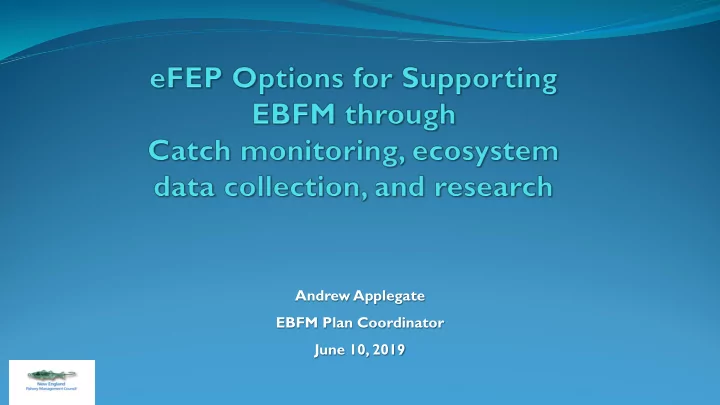

Andrew Applegate EBFM Plan Coordinator June 10, 2019
PDT discussion document Catch monitoring, data collection, and ecosystem research Current data collection can support EBFM modelling, assessment, and management Verifiable data that accurately identifies what is happening in and on the water is essential for long-term sustainable management Increased participation by fishermen (and others) to enhance fishery, survey, and research data can increase capacity and improve transparency 9
Enhancements Catch monitoring, data collection, and ecosystem research Modernize fishery dependent data collection Real-time, verifiable, reliable Catch monitoring Hotspots Accountability Ecosystem data Sampling a wider variety of habitats and spatial scale Socio-economic indicators Habitat and gear effects data 10
Enhancements Catch monitoring, data collection, and ecosystem research Ecosystem research Catchability studies Food habits data and consumption estimates Stock movement, mixing, and migration Changes in habitat and the effect on stock productivity Linkages between primary productivity, energy transfer, and biomass of higher trophic levels 11
Enhancements Catch monitoring, data collection, and ecosystem research Ecosystem research (addition to 4e) Fishery production is directly related to the amount of energy coming in at the base of the food web through phytoplankton production. Phytoplankton production is estimated using satellite observations and is calibrated using direct shipboard sampling when possible. Estimates of small- and large- celled phytoplankton production are currently used directly in the NEFSC Fishery Production Potential (FPP) model and in Ecopath with Ecosim (EwE). The FPP model uses externally-derived estimated of energy transfer efficiency . EwE production estimates can be used to internally estimate transfer efficiencies. Currently and EWE model is under development for Georges Bank and when available, these new estimates of transfer efficiency can be used in the FPP model. 12
Committee consensus 1) Accurate catch monitoring is important, regardless of whether stocks are managed singly or as an ecosystem, but there are no novel issues to be addressed in the eFEP. Removals by stock will still be needed to assess stock condition and evaluate the biological/energetic relationships among them. 2) Unbiased and accurate landing reports and discard estimates for commercial and recreational fishing will be needed and should be improved. 3) Maximum retention policies could improve catch estimation, but could come at a cost which may be mitigated through developing markets. 13
Committee consensus 4) Understanding the relationship between the survey abundance indices and stock trends is important and should be improved. 5) The use of catch and survey data in assessments and in management should be streamlined and transparent. Operating models should account for a range of time lags between data collection, assessment, and management response. 6) New or expanded types of environmental monitoring could improve our understanding and management of the ecosystem in a more adaptive and responsive way, but collecting these data have costs (which may be offset in other ways, such as less frequent sea sampling). 14
Andrew Applegate EBFM Plan Coordinator June 13, 2019
EBFM PDT Discussion document Approaches with case studies being written for the July 24 EBFM Committee meeting Focus on how IBMs could work with proposed Ecosystem Management framework Sector type approach Point system approach Tariff based approach Quantity based approach – market and size category structure 26
Andrew Applegate EBFM Plan Coordinator June 13, 2019
EBFM PDT Discussion document Jurisdictional authority, cooperation and coordination Drafted 2016 – recent management changes? Majority of species caught in the Georges Bank EPU are managed by the NEFMC Cooperation and coordination among management bodies will be needed Separate and uncoordinated management of related species is a core EBFM issue Agree common ecosystem constraints and major FEP goals 28
EBFM PDT Discussion document Jurisdictional authority, cooperation and coordination Preferred approach loosely modelled after US-Canada sharing agreement Similar framework: Core goals and objectives, as well as non-binding guidance on US and Canada harvest levels for Eastern Georges Bank cod, haddock, and yellowtail flounder 29
Examples 30
EBFM PDT Discussion document Jurisdictional authority, cooperation and coordination Proportion of stock catch limit applicable to the Georges Bank EPU would be calculated based on agreed formula Becomes part of the applicable stock complex catch limit Catch outside of the Georges Bank EPU not controlled by EPU limits Rebuilding plans and targets determined as they are now Georges Bank EPU species managed by other bodies would require their review and approval. Possible expansion of TMGC for ecosystem resources shared with Canada 31
Recommend
More recommend